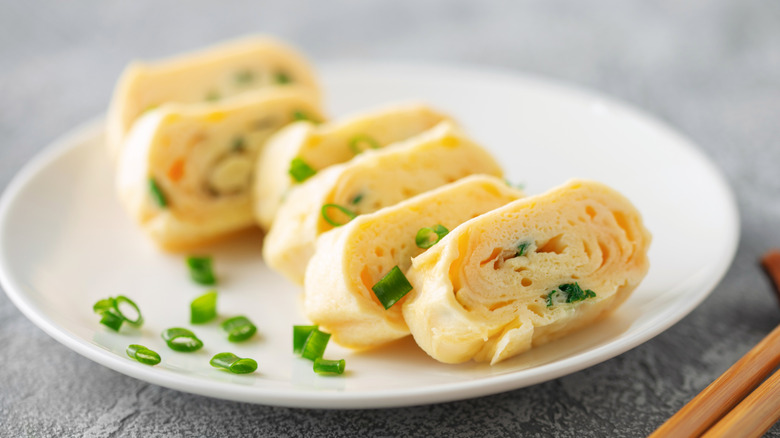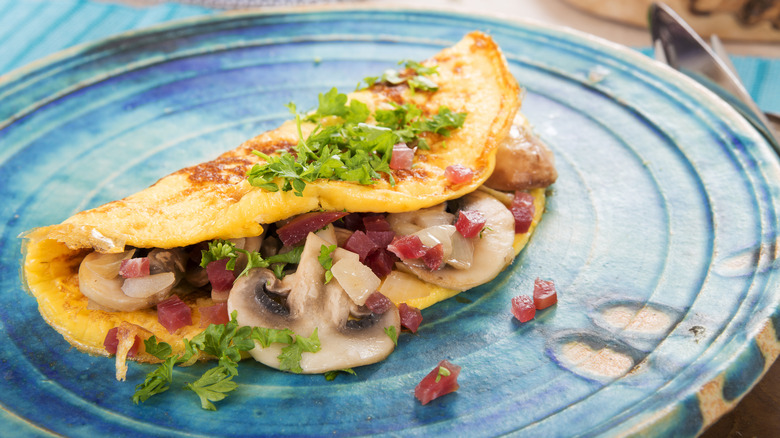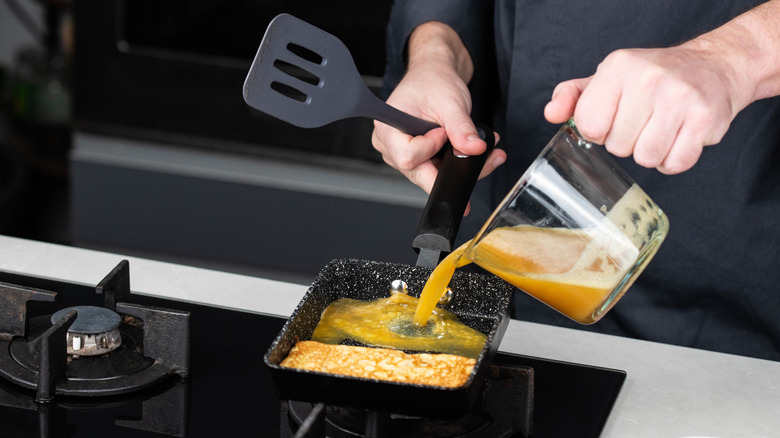Tamagoyaki Vs Western Omelets: What's The Difference?
What omelets are to Europe and the United States, tamagoyaki is to Japan. The breakfast staple features beaten eggs and seasonings cooked to a golden yellow hue and rolled to perfection. Considering the simplicity of both dishes, it's a little stunning how difficult each can be to perfect. It's common for upscale restaurants to test a new chef by way of their interpretation of an omelet (there's even an episode of "The Bear" titled Omelette). It's not so different in Japan. Chef Daisuke Nakazawa, of New York's Sushi Nakazawa, told Serious Eats' Daniel Gritzer that it took him 10 years to perfect the tamagoyaki served at his restaurant. So what's the difference between the two egg dishes?
On the surface, the dishes are indeed related. But there are some pretty significant differences regarding ingredients and the kitchen tools used to create them properly. In short, a proper omelet involves butter and the right sized round pan or griddle surface. In place of dairy, tamagoyaki uses an umami soup stock and other flavorings for its binder, and it's rolled multiple times into thin layers. Don't worry: Despite the intense training required to make each dish perfectly, they're both pretty easy for home cooks to reproduce.
The Western omelet leans on butter
Whether spelled omelet or omelette, the dish is deceptively simple. Beat some eggs with salt and pepper, pour them into a pan with oil or butter, let the mixture set a bit, then roll or fold it, perhaps with some fillings. As minimalist as that seems, there are so many ways to make an omelet wrong. But following simple tips (and a lot of practice) can help avoid breakage, rubbery eggs, or burning.
There's a great deal of variety when it comes to construction. A proper French omelette consists of three eggs, a bit of butter or ghee, salt, and sometimes cheese as a filling or topping. It's rolled three times, and it's vital the eggs don't brown or burn in the pan. For larger American omelets, eggs may be whisked with cream cheese or butter, browning is okay, and they're often filled to the brim with meat, cheese, and vegetables. Once cooked, they can be folded in half or like a burrito.
For perfect omelets, the right tools help. An 8- to 10-inch nonstick pan is best for a single serving, like the Made In Cookware ProCoat 10" option. Take the hassle out of folding an ingredient-loaded American omelet with a folding pan, like the Techef frittata and omelet pan. Upgrade your spatula by going narrow, like the Zopeal thin silicone spatula for omelets or crepes, or opt for something wide like the Chef Craft Select jumbo turner.
Tamagoyaki is all about rolled layers
While the omelet can be traced back to the Roman empire, earning its name in 16th-century France, tamagoyaki's history is murkier. Chicken eggs were introduced during Japan's Edo period (1603-1867), but the dish wasn't fully defined until the 1860s. Instead of butter, tamagoyaki uses a flexible blend of dashi (soup stock), soy sauce, mirin, and sugar. Different regions of Japan tend to prefer sweet or savory notes or a golden yellow hue versus careful browning, and they adjust the mix accordingly.
To make tamagoyaki, a thin layer of egg is rolled up as it sets using chopsticks (usually). A second layer is then poured, cooked, and rolled around the first. This step is repeated one or two more times. Shaped into a squared tube using a sushi mat, tightly rolled eggs are sliced into bite-sized pieces and served warm or chilled alongside other Japanese breakfast items like salmon, miso soup, and rice. While it can take years to perfect, the basics are usually graspable after two or three tries.
Besides the sweet-and-umami dashi mix, the biggest difference is in the specific cookware. While experienced chefs use a large, square tamagoyaki pan, home cooks should go for a lightweight, 5-by-7-inch version like the Iwachu cast iron omelet pan. Or pick up a kit from YumOmNom or HappiStudio, and get the pan plus accessories like cooking chopsticks and a specially designed spatula, either of which work well for rolling eggs tightly.


